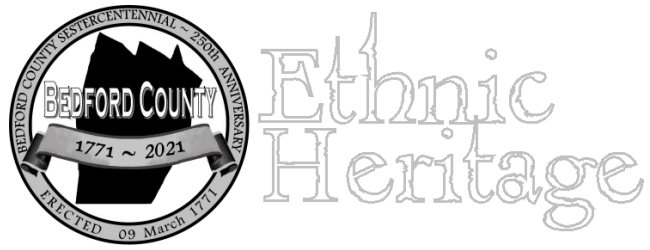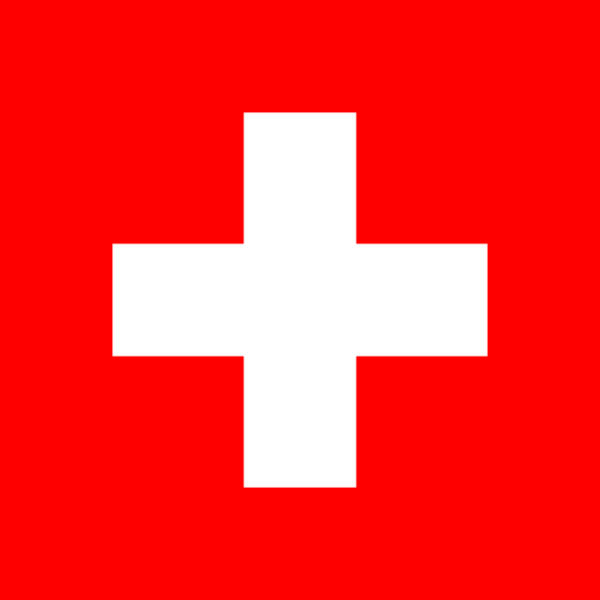
Swiss~American Day
01 August 2021

The American Community Survey, compiled between 2008 and 2012 and being the most recent analysis, identified 1% of the total population of Bedford County as descending from Swiss ancestors.
Swiss National Day, celebrated on the 1st of August, commemorates the date in 1291 that three cantons (Schwyz, Uri and Unterwald) joined together as the Swiss Confederacy. Celebration of the Confederacy dated to 1291, though, is a recent phenomenon. For many generations, the anniversary of the legendary oath agreed to by the three cantons, known as the Rutlischwur, was celebrated on 8 November, and it was believed to date to 1307 (primarily on the say-so of the 16th Century historian, Aegidius Tschudi). The discovery that the oath of confederation actually dated to 01 August 1291 was made in 1889 and the holiday gained favor in the 1940s.
Switzerland is the name by which the Swiss Confederation is known to the English speaking people. The country has five other 'official' names according to its neighbors and their languages. Germany, which borders to the north, knows the country as Schweizerische Eidgenossenschaft. France, bordering to the west, calls it Confederation Suisse. Confederazione Svizzera is how Italy, to the south, knows her. In the canton of Grisons, located in the southeast region of the country, the language predominantly spoken by the inhabitants is Romansh, and the Romansh name for the country is Confederaziun svizra. And lastly, a holdover from the Holy Roman Empire is the Latin name for the country: Confoederatio Helvetica.
What about William Tell? The life and exploits of William Tell, including the incident in which he shot an arrow through an apple placed on his son's head, are legendary. That means that the man's physical existence cannot be proven by documented records. The legends place Tell at the center of the creation of the Swiss Confederacy at the end of the 13th Century. The legends state that the crossbow expert used that weapon to kill Albrecht Gessler, the tyrannical chief magistrate of the town of Altdorf, the capitol of the Canton of Uri. William Tell's courage and defiance against the tyranny of Gessler emboldened the people not only of the Canton of Uri but the neighboring cantons of Schwyz and Unterwald. Although his sources were suspect, the narrative of Aegidius Tschudi stated that Magistrate Gessler raised a pole in the town square of Altdorf, hung his hat on the pole and then demanded that all townsfolk passing it must bow before it. As the legend continued, Tell and his son came into the town and passed by the hat on the pole. He did not bow and was immediately arrested. Both Tell and his son were both condemned to death. Gessler gave Tell a way to avoid being killed. He promised Tell and his son clemency if the father could shoot an apple off the son's head. The arrow cleanly split the apple without harming the child. But William Tell did not pull just a single arrow from his quiver. When questioned about the second arrow, Tell announced that had he accidently killed his son, the second arrow would have been used to pierce the heart of the tyrant. Gessler kept his word that he would spare Tell and his son's lives, but he still had him bound with the intention of imprisoning him for life in the dungeon of his castle at Kussnacht in Canton Schwyz. Enroute to that captivity, William Tell escaped and later ambushed Gessler. He shot the tyrant with his crossbow, which action sparked the people to rise up and rebel. The Swiss Confederacy was the result of that rebellion.
The celebration of Swiss National Day is often expressed in parades, fireworks and bonfires. Giving a nod to the legends of the Swiss hero, William Tell, some celebrations feature crossbow competitions. In many Swiss communities in the Alpine motherland and in the Swiss diaspora, as night comes on, the bonfires are lit, with neighbors and/or communities vying to make the largest. Children will walk through the community carrying lighted paper lanterns decorated with red backgrounds and the white cross, symbolic of Switzerland's flag. One of the unique activities in which musicians participate on Swiss National Day is the playing of the alphorn, which permits a range of three octaves. Unlike her more boisterous neighbors on their national holidays, Switzerland (and hence the Swiss~Americans) tend to spend the day in a more contemplative attitude.
Traditional Swiss foods tend to mimic the foods loved by her French, German, Austrian and Italian neighbors. Sausage in all its German and Austrian forms is a standard of Swiss cuisine. It might surprise many people to know that of all the forms of sausage available to them, Swiss and their Swiss~American cousins might choose Vienna Sausages as their favorite. The short lengths of ground pork and beef stuffed in thin casings are either parboiled or smoked, and may be eaten straight from their can or jars. The Swiss eat Vienna Sausages in a number of dishes. Although a German dish consisting of pork wrapped in cabbage leaves is called Pigs In A Blanket, the Swiss version of a dish by that name consists of Vienna Sausages wrapped in dough. The tops of the dough wrapped sausages are brushed with butter and sprinkled with poppy seeds before being baked. Vienna Sausages are often included in vegetable stir-fries. Thinly sliced, Vienna Sausages are fried with rice and diced bell peppers. Another type of sausage deserves special mention. Named Cervelat in its homeland, the smoked combination of beef, pork rind and bacon is found in the United States as Summer Sausage. Cervelat is enjoyed equally well raw, cooked, fried or boiled.
Another meat dish that originated in Switzerland is Cordon Bleu. The dish may use pork or veal, but in either case, the meat is butterfly cut and a slice of ham and cheese is inserted between the two halves. The outside is coated in bread crumbs and then it is deep fried. A variation of the dish uses a chicken breast in place of the pork or veal. Swiss Steak is a dish whose origin is included in its name. Swiss steak consists of beef that is pounded to tenderize it before being braised. The piece of beef is seared in a skillet and then cooked in a stew of vegetables before being served covered with mushroom gravy. Although it is not specifically a meat dish, Capuns uses meat as a primary ingredient. The preparation of Capuns starts with mixing together flour, eggs, milk, spices such as rosemary, basil, oregano and mint, pieces of the semi-dried sausages known as either 'landjaeger' or 'salsiz', bacon and shredded hard cheese. After the mixture is thoroughly mixed, it is placed onto leaves of chard, a vegetable of the beet family. The leaves are folded to enclose the mixture and then they are placed in a pot, and cooked in a gravy consisting of milk and bouillon. The Capuns are eaten, chard leaves and all, sprinkled with grated cheese. A dish that hails from Zurich is called Zurcher Geschnetzeltes, or Zurich Ragout. In this ragout, or stew, veal loin or pork loin is sliced into thin strips. The meat is sauteed in a skillet and thinly sliced mushrooms and shallots are fried in butter in another pan. Flour is sprinkled over the mushrooms and shallots and a cup of white wine and some cream are added. When the sauce is reduced by a half, the browned meat strips are added to the pan. The whole is rewarmed and served sprinkled with parsley.
Cheese is another food that the Swiss are famous for. Most of the cheese produced in Switzerland is eaten directly from a block, but there are a few dishes that incorporate cheese as a primary ingredient. A dish that originated in the Alpine region of Switzerland as early as the 13th Century is Raclette. A large wheel of semi-hard cheese is held before a fire or other source of heat causing its face to melt. The melting cheese is scraped off onto the diners' plates to serve as a sauce to various other food items such as steamed potatoes. Melted cheese is not limited to Raclette. Fondue is also a traditional Swiss culinary invention, but unlike Raclette, the cheese is melted in a pot. Small pieces of cooked meat, bread or potatoes are stuck on the end of skewers and dipped into the melted cheese. A variation of fondue is the substitution of oil for the cheese. Uncooked meat dipped in the oil is then cooked. Another variation is melting chocolate in the pot and dipping pieces of pastry of fruit into it.
Rosti, a sort of potato pancake or fritter, is a popular Swiss breakfast dish. In America, the potato dish called hash browns is similar to Rosti. It is usually eaten with 'sunny-side-up' fried eggs (commonly called 'dippy' eggs).
In regard to what people normally will drink on Swiss National Day, beer, giving a nod to their German and Austrian neighbors, and wine (which is often thought of as the 'national drink') top the list of alcoholic favorites. In wines, the Pinot Noir and Merlot varieties of grapes are grown extensively in the 'French' regions of Switzerland. The Swiss also grow the grape variety named Chasselas, which is quite popular when paired with the raclette and fondue dishes. One might also think that topping the list of non-alcoholic drinks would be cocoa. But despite the prevalence of chocolate processing companies in the country, the Swiss actually drink more herbal tea and coffee than cocoa. For cocoa and chocolate-loving Swiss~Americans, it might be of interest to know that one of the most loved chocolate brands in the motherland is Caotina.
Additional Information Might Be Added Here. Please Check Back.
Click on this logo to return to the Calendar page.

